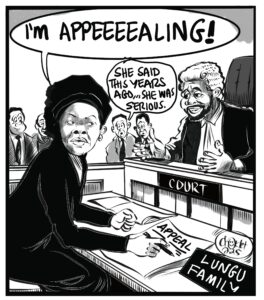FORMER Zesco board chairperson Mbita Chitala says there was an attempt by various government bureaucrats to asset strip Zesco Limited.
In his book, entitled “CORPORATE CAPTURE: THE POLITICAL ECONOMY OF ELECTRICITY MANAGEMENT IN ZAMBIA”, Chitala said attempts to strip Zesco were from Smart Zambia Institute and the Industrial Development Corporation (IDC).
“One of the most unacceptable conduct was the attempt by the various government bureaucrats to asset strip ZESCO Limited which in the end contributed in my parting of ways with the company to give them a free reign. The first attempt was made by bureaucrats under the so called Smart Zambia Institute (SZI) while the second attempt was made by the management of the Industrial Development Corporation (IDC). Firstly, there was the case of Smart Zambia Institute (SZI). The government established what they called Smart Zambia Institute (SZI) which was headed by a deputy secretary to the Cabinet Dr Martin Mtonga. The SZI, through the government of Zambia had entered into an agreement with Huawei Technologies company Limited to provide a platform for e-governance in Zambia. The agreement was for the design, supply, delivery, installation and commissioning of a National Optic Fibre Broadband Network (Backbone) Metropolitan Area Network (Metro) and Access Network (Access) designated as lots 1, 2 and 3 respectively under the Smart Zambia Phase II Project. A large portion of the project scope involved the installation of equipment on the existing ZESCO infrastructure,” he said.
“ZESCO was told by the said Mr Mtonga that the Smart Zambia Phase II Project was aimed at improving communication, reducing the cost of doing business, spur ICT development and bridge the digital divide in the country as well as improve government service delivery to business entities, citizens and within government institutions. The project involved the extension of the ZESCO National Optical Fibre backbone by 2, 700 Km and covering 64 backbone sites; the establishment of a metropolitan Area Network with a cumulative cable distance of 3, 600 Km across 17 districts in Zambia; and to implement full IP based Access
Network to cover 2, 750 Km covering 17 districts.”
He said from the onset, the company had observed the difficulties in the project as it was not transparent.
“To achieve this programme, ZESCO was informed that a concessional loan agreement had been signed between the Ministry of Finance representing the government of Zambia and export and import Bank of China (EXIM Bank) on 24th February, 2017. ZESCO was informed that this loan contracted with a view to on-lend the facility to ZESCO Limited who would also absolve all the
liabilities of the loan. Smart Zambia Institute identified ZESCO Limited to be its strategic partner in the implementation of the project because over 70% of the project implementation depended on the ZESCO infrastructure. ZESCO also learned that the government of Zambia through the Cabinet Office and Huawei Technologies Company Limited had signed the US$ 392 million contract on 24th February, 2017. In addition, ZESCO learned that on 28th December, 2017, the government through the ministry of Finance and the Export and Import Bank of China Signed a preferential buyer credit loan Agreement for a total sum of US$ 332 million,” Chitala stated.
Zesco was informed by Smart Zambia about the loan amount as presented. Zesco was informed that this amount would be on-lent to Zesco limited. Zesco was further informed that advance payment of 15% of the loan had already been paid by the Ministry of Finance to Huawei which brought the total contract amount to USD 392 million. From the onset, ZESCO observed the difficulties in the project. It was clearly non-transparent and the ZESCO Board immediately brought this matter to the government officials that were advancing the project. ZESCO observed that Huawei had presented a solution to Smart Zambia for the optic fibre backbone network whose connection matrix was the same as what was existing in Zesco’s Fibrecom except for 4 links, namely mongu – lukulu, Kaoma – Mumbwa; Nakonde – Mbala and Chama – Nakonde.”
He said it was evident, according to ZESCO analysis, that the whole project was a conspiracy to defraud Zambia.
“Furthermore, Huawei had proposed to Smart Zambia to install their equipment in the same location as those already installed by ZESCO’s Fibreson Network. Huawei wanted to configure their equipment as redundancy to the existing ZESCO equipment which was basically to duplicate the ZESCO infrastructure and ZESCO noted that this was not necessary as ZESCO network rings were
able to achieve that objective,Furthermore, the equipment of Huawei was not compatible with ZESCO existing network. In fact, it was 3rd generation equipment while ZESCO’s equipment was 4th generation which was far superiorto the one HUAWEI wanted to install. ZESCO further observed that the equipment that was being supplied to Smart Zambia Institute had a total transmission capacity of 100 abps .On the other hand, Zesco installed transmission capacity was 400abps and that the suggestion to close ZESCO network would not only be retrogressive to Zambia needs but was a bad business deal,” he stated.
“Furthermore, ZESCO observed that Smart Zambia Institute had not conducted any on -site survey to justify the quantification of the Bill of Materials. The figures totalling USD 392 million that were submitted to ZESCO for the project scope were based on desktop estimation. ZESCO considered this omission as gravely unprofessional. It was evident according to ZESCO analysis that the whole project was a conspiracy to defraud Zambia. Huwaei proposed a solution that was not only inferior to ZESCO existing network, but covered the same towns as those covered by ZESCO on the Metropolitan Network. Huwaei and Smart Zambia Institute proposed to use equipment whose end- of the market (EOM) was in 2013 and they further failed to provide to ZESCO a financial model of their business proposal on how ZESCO would have its Return on Investment (ROI).”
Chitala said there was pressure from government officials including the Secretary to Cabinet for Zesco to accept the Huawei Project and sign the on-lent loan of $392 million.
“Then, all sorts of Individuals ranging from the Secretary to the Cabinet and politicians put pressure on ZESCO and its staff to accept the Huawei project and sign the on- lent loan of USD 392 milion. The proponents for this were Huawei, Smart Zambia, the secretary to the cabinet Dr Msika and later Dr Simon Miti and his deputy secretray to the cabinet Mr. Christopher Mvunga and some officials from State House,” he said.
Chitala said he was called and warned by former president Edgar Lungu to cancel a board meeting to discuss the possibility of an on-lend to Zesco of $392 million as it was more scandalous than the fire tenders deal.
“The pressure on the ZESCO Board and management was so much that I, as chairman was concerned that some people could get hurt. It was obvious that some people had either already benefitted from the deal or were being prevented from benefiting. Some of the members of the ZESCO management expressed genuine fear of the situation and requested for my protection. I summoned an urgent meeting of the ZESCO Board to resolve on the matter. Before the meeting could start, the President of the Republic who had been briefed of the meeting by the ZESCO managing director of the situation called me on the phone and advised me that the meeting should not be held as the matter the ZESCO Board was about to discuss on the possibility of on- lend to ZESCO of USD 392 million for Smart Zambia was more scandalous than the buying of 40 fire tenders at USD 1 million each,” he said.
“The President advised me to cancel the meeting which I gratefully did as I had planned to resign from the board if the board members resolved in the affirmative to accept the on-lent loan. I had earlier made up my mind that if the board accepted that ZESCO receive the USD 392 million as on lent to Zesco by the Ministry of Finance knowing that ZESCO Limited could not accommodate the loan on its balance sheet and further knowing that the loan was essentially a way of defrauding Zambia, I would respectfully resign as chairman and board member of ZESCO Limited. Fortunately, the president of the Republic Mr Edgar Changwa Lungu forewarned me of the attempted fraud and I was able to cancel the extra-ordinary board meeting of the ZESCO Board.”
He said more than US$60 million which the Ministry of Finance released as its 15 percent counterpart contribution funding for the loan was not only wrongly released but was also grossly abused.
“It was also common knowledge that the more than US$ 60 million that the Ministry of Finance released as its 15 percent counterpart contribution funding for the loan was not only wrongly released but was also grossly abused and that many people may have received bribes on that deal and hence the pressure on ZESCO to accept the UD$ 392 million on-loan lent instructions. It was also apparent that since government money had been expended without any work to show for, this would add to the other scandals that the Auditor General used to publish as examples of abuse of public office of trust or common theft of public resources by politicians and public servants,” said Chitala.
“This matter did not die with the rejection of ZESCO of the facility but was resurrected in another form by management of the Industrial Development Corporation (IDC). The bureaucrats had to find a way of justifying this expenditure and I and the ZESCO Board appeared to be in the way of this criminality.”
























